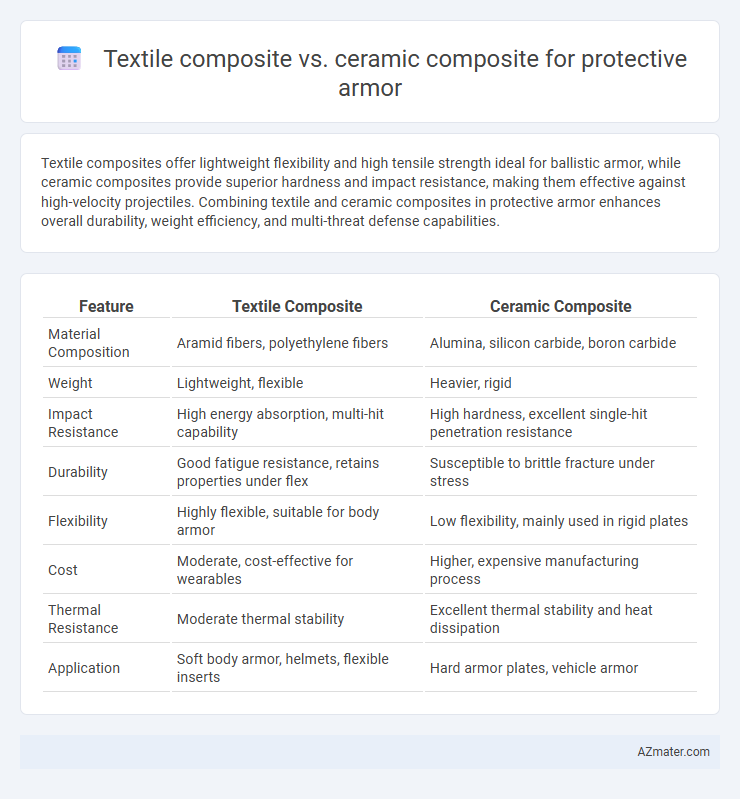Textile composites offer lightweight flexibility and high tensile strength ideal for ballistic armor, while ceramic composites provide superior hardness and impact resistance, making them effective against high-velocity projectiles. Combining textile and ceramic composites in protective armor enhances overall durability, weight efficiency, and multi-threat defense capabilities.
Table of Comparison
| Feature | Textile Composite | Ceramic Composite |
|---|---|---|
| Material Composition | Aramid fibers, polyethylene fibers | Alumina, silicon carbide, boron carbide |
| Weight | Lightweight, flexible | Heavier, rigid |
| Impact Resistance | High energy absorption, multi-hit capability | High hardness, excellent single-hit penetration resistance |
| Durability | Good fatigue resistance, retains properties under flex | Susceptible to brittle fracture under stress |
| Flexibility | Highly flexible, suitable for body armor | Low flexibility, mainly used in rigid plates |
| Cost | Moderate, cost-effective for wearables | Higher, expensive manufacturing process |
| Thermal Resistance | Moderate thermal stability | Excellent thermal stability and heat dissipation |
| Application | Soft body armor, helmets, flexible inserts | Hard armor plates, vehicle armor |
Introduction to Protective Armor Materials
Textile composites for protective armor primarily utilize high-strength fibers such as Kevlar, Dyneema, or Spectra, offering lightweight flexibility and excellent energy absorption against ballistic threats. Ceramic composites combine hard ceramic plates, like alumina or silicon carbide, with backing materials such as ultra-high-molecular-weight polyethylene (UHMWPE) or fiber-reinforced polymer to deliver superior hardness and resistance against armor-piercing rounds. The choice between textile and ceramic composites depends on the required balance of weight, mobility, impact resistance, and threat level in modern body armor applications.
Overview of Textile Composites
Textile composites for protective armor primarily consist of woven fibers such as aramid, UHMWPE, or carbon fibers embedded in a polymer matrix, offering high flexibility and lightweight protection against ballistic threats. Their energy absorption mechanism relies on fiber tensile strength and deformation under impact, making them ideal for wearable applications requiring comfort and mobility. Compared to ceramic composites, textile composites provide enhanced multi-hit capability but generally lower hardness and penetration resistance against high-velocity projectiles.
Overview of Ceramic Composites
Ceramic composites for protective armor combine high-hardness ceramic materials such as alumina, silicon carbide, or boron carbide with tough fiber reinforcements to enhance impact resistance and reduce brittleness. These composites offer superior ballistic protection by shattering incoming projectiles while dissipating energy through the composite matrix, making them ideal for military and law enforcement applications. Their lightweight nature and high compressive strength provide enhanced protection compared to traditional textile composites, especially against high-velocity threats.
Key Differences in Material Composition
Textile composites for protective armor primarily consist of high-performance fibers such as Kevlar, Dyneema, or Twaron embedded in a polymer matrix, offering flexibility and lightweight properties. Ceramic composites incorporate hard ceramic materials like alumina, silicon carbide, or boron carbide combined with a metallic or polymeric matrix to deliver superior hardness and ballistic resistance. The fundamental difference lies in the balance between the flexibility and energy absorption of textile composites versus the extreme rigidity and penetration resistance provided by ceramic composites.
Comparative Mechanical Properties
Textile composites offer high tensile strength and flexibility, making them ideal for lightweight ballistic protection with excellent energy absorption. Ceramic composites provide superior hardness and compressive strength, effectively dissipating high-velocity impacts but tend to be brittle and heavier. Combining textile and ceramic layers often results in optimized protective armor with balanced mechanical properties such as enhanced toughness, impact resistance, and reduced weight.
Ballistic Performance Comparison
Textile composites, such as Kevlar and UHMWPE, exhibit high energy absorption and flexibility, enabling multi-hit ballistic protection with reduced weight. Ceramic composites, typically alumina or silicon carbide combined with backing materials, offer superior hardness and fragmentation resistance, effectively defeating high-velocity projectiles by shattering bullets upon impact. In ballistic performance, ceramic composites provide higher protection against armor-piercing rounds, while textile composites excel in trauma attenuation and lightweight mobility for body armor applications.
Weight and Flexibility Considerations
Textile composites in protective armor offer superior flexibility and significantly lower weight compared to ceramic composites, making them ideal for applications requiring enhanced mobility. Ceramic composites, while heavier and less flexible, provide exceptional hardness and ballistic resistance, critical for high-impact threats. Balancing weight and flexibility, textile composites are preferred for lightweight, wearable armor systems, whereas ceramic composites are favored when maximum protection is paramount despite added bulk.
Durability and Environmental Resistance
Textile composites in protective armor offer high flexibility and impact absorption but typically exhibit lower durability against abrasive wear and extreme temperatures compared to ceramic composites. Ceramic composites provide exceptional hardness and superior resistance to ballistic impacts, maintaining structural integrity under harsh environmental conditions such as high heat, moisture, and corrosive elements. Combining ceramic layers with textile composites can optimize the balance between durability, environmental resistance, and weight for advanced armor solutions.
Cost and Manufacturing Implications
Textile composites for protective armor offer lower manufacturing costs due to simpler fabrication processes and the use of readily available fibers like aramid or ultra-high-molecular-weight polyethylene (UHMWPE). Ceramic composites, while providing superior ballistic resistance, involve higher production expenses driven by advanced sintering techniques and the need for specialized raw materials such as boron carbide or silicon carbide. The cost-benefit analysis must weigh textile composites' affordability and ease of mass production against the enhanced durability and protection levels afforded by ceramic composites.
Application Suitability and Future Trends
Textile composites offer high flexibility and impact resistance, making them ideal for lightweight body armor and ballistic helmets used in military and law enforcement applications. Ceramic composites provide superior hardness and resistance to high-velocity projectiles, making them suitable for vehicle armor and tactical plates in combat zones. Future trends indicate a hybrid approach combining textile and ceramic composites to enhance multi-threat protection while reducing weight and improving mobility for soldiers.

Infographic: Textile composite vs Ceramic composite for Protective armor
 azmater.com
azmater.com